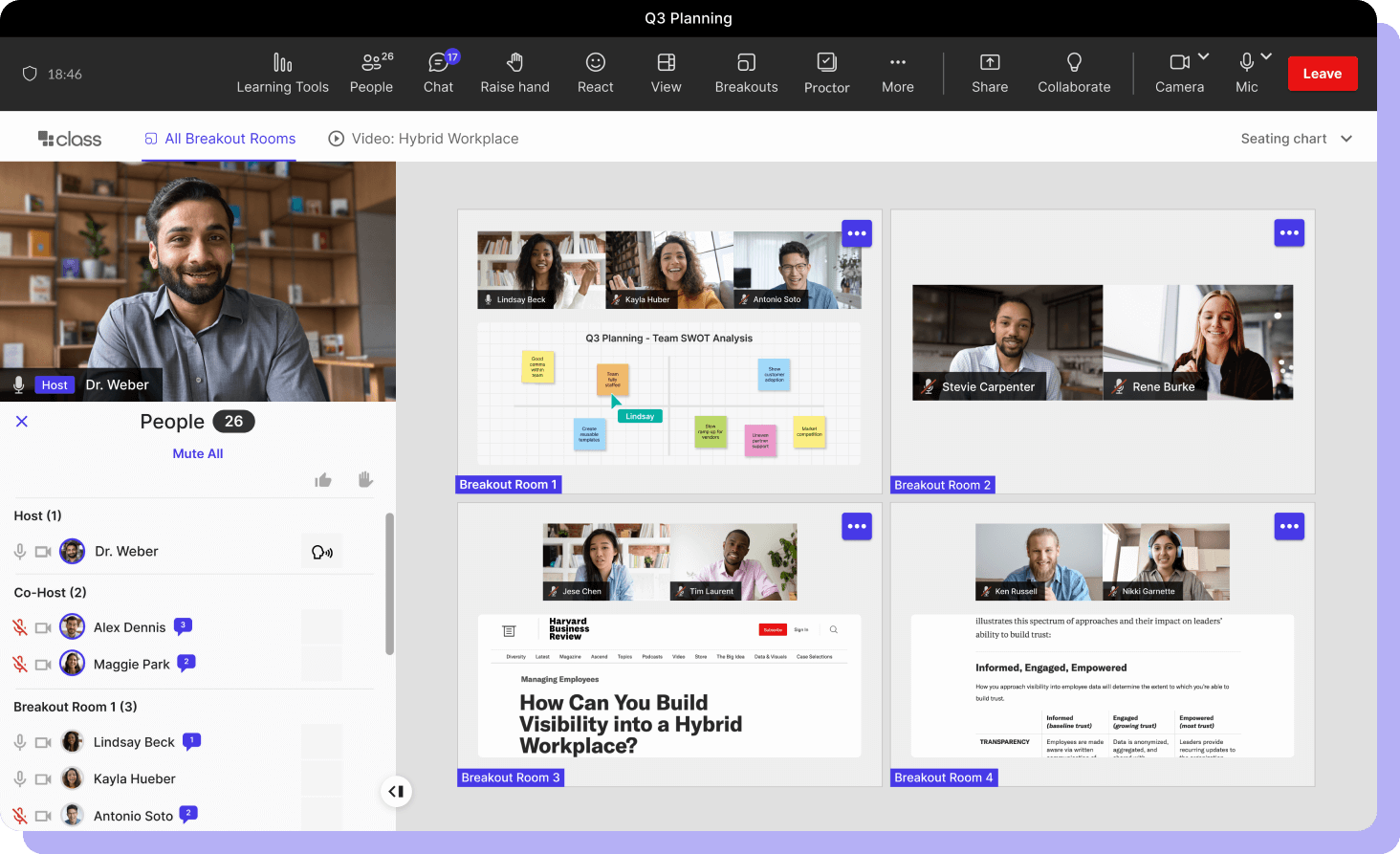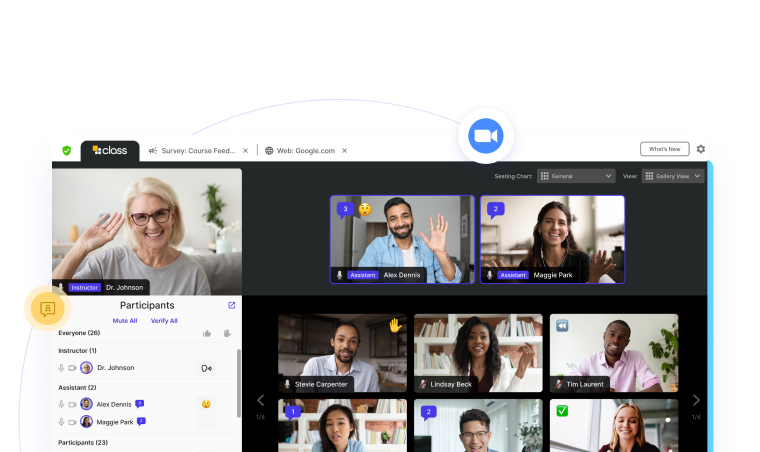
Dalton specializes in connecting organizations with technology that drives performance and growth. With experience supporting companies from startups to global enterprises, they focus on aligning meaningful solutions with real operational needs.

Dalton specializes in connecting organizations with technology that drives performance and growth. With experience supporting companies from startups to global enterprises, they focus on aligning meaningful solutions with real operational needs.

Many trainers and instructional designers have high hopes when launching breakout rooms in the virtual classroom. They expect groups to dive into the task, collaborate, and return with new ideas, ready to present to the rest of the class. Too often, these moments fall flat. Participants might seem distracted, unengaged, or even confused. Facilitators feel stretched thin as they juggle jumping between rooms, checking in with each group, offering support where it’s needed, and keeping the session on track.
The challenge of using breakout rooms to conduct group work during virtual learning isn’t oriented around any one thing or process. Setting up, managing, and supporting small group work can be time-consuming, overly complicated, and overwhelming. However, with the right approach and tools, group activities in virtual settings can be just as impactful as their in-person counterparts, shifting from juggling tech that doesn’t quite feel built for the task to a real driver of learning and engagement.
Small group work remains a key strategy for deeper learning. Research and decades of classroom experience point to the value of peer-to-peer dialogue, problem-solving, and active practice, all of which are facilitated through small group collaboration. In the virtual environment, these benefits become even more important because screen fatigue, overly long passive lectures, and distractions in a participant’s physical space are always lurking. However, breakout rooms can quickly become the place where thoughtful practice and interaction lose momentum. Trainers lack visibility into what’s happening inside each room. Learners may feel disconnected from the larger purpose or hesitate to participate. Sometimes, the session stalls while facilitators juggle technical challenges. Without structure and support, group work misses the mark and training outcomes suffer.
A few core practices help turn virtual group work into a valuable experience, regardless of the technology in use. At the heart of effective group work are thoughtful design choices and facilitation strategies that foster trust, purpose, and accountability. With the right groundwork, facilitators can create an environment where learners stay engaged, feel supported, and achieve meaningful outcomes, even when working within the constraints of basic platforms.
Every breakout should have a specific purpose. Participants need to know exactly what they’re being asked to do and what success looks like. Provide prompts, instructions, or a shared checklist so everyone starts with confidence. When expectations are explicit, learners are more likely to participate fully and stay focused throughout the activity.
Encouraging roles such as facilitator, note-taker, or timekeeper help every participant stay involved. Roles foster accountability and keep discussions focused. This structure prevents any one voice from dominating and gives everyone a reason to contribute, building a stronger sense of ownership within each group.
Before opening breakout rooms, bring everyone together in the main room for a quick briefing. Clarify the task, set expectations, and answer any questions. This step helps reduce confusion and sets a positive tone. A thorough orientation helps to ensure everyone feels prepared and less anxious about what will happen next.
Set a clear time limit for the breakout activity and define what each group should accomplish. Whether it’s a summary, a decision, or a draft, having a tangible goal keeps the group on track. Pacing the activity this way can help groups avoid getting sidetracked or bogged down in off-topic conversations.
During breakouts, visit each group for short check-ins. Offer guidance, answer questions, and nudge progress as needed. These visits provide support without taking over the conversation. Active facilitation helps identify stumbling blocks early and keeps energy focused across rooms.
After the breakout session, reconvene the full group. Invite each team to share their findings or ideas. This debrief not only spreads learning but reinforces the connection between group work and the session’s overall objectives. Closing the loop with a group report-out gives everyone a sense of accomplishment and shows how each group’s efforts contribute to the bigger picture.
Many trainers know the pain of managing breakouts with basic video conferencing and meeting platforms. Preparing breakout rooms often means juggling spreadsheets or chat messages just to divide people into groups. Sharing content requires extra clicks, and all groups usually receive the same materials, which can limit creativity or differentiated learning. While facilitating, the trainer must move from room to room with little insight into group dynamics until entering the space. This limited visibility can hinder collaboration, create moments of uncertainty, and lead to missed opportunities for support.
Purpose-built platforms can change the entire experience for facilitators and learners. Class was designed specifically for virtual instruction and training, offering features that go beyond standard meeting tools. These advancements directly enable the core strategies that make small group work effective, such as providing targeted support, promoting active participation, and creating differentiated learning experiences. With the right platform, facilitators gain visibility, flexibility, and control that standard video platforms simply can’t match, empowering them to run more engaging, purposeful breakout sessions.

Class offers a level of breakout room oversight not possible in standard platforms. With a bird’s-eye view of all rooms—including real-time engagement gauges, optional live transcripts, and seamless room switching—facilitators can focus their attention where it’s needed most. This visibility allows trainers to provide timely guidance and support, catch confusion or disengagement early, and keep every group on track, all without disrupting the flow of discussion.
Class empowers facilitators to deliver unique content, instructions, or assignments to each breakout group. This flexibility makes it easy to tailor activities to different skill levels, learning objectives, or project types. By providing group-specific tasks, trainers can create more targeted and meaningful learning experiences, ensuring that every group is challenged and engaged.
With Class, breakout rooms and their materials can be set up before the session even begins. This advanced setup streamlines transitions into group work, reduces downtime during the live session, and ensures that each room has the right mix of participants and resources.
Class automates many of the manual and technical tasks that can bog down live virtual training. With fewer distractions from logistics, facilitators can dedicate more energy to supporting learners. By shifting to a platform designed for training—not just meetings—facilitators can create small group experiences that drive deeper engagement and learning.
Virtual small group work has the potential to create deep engagement and real learning, but reaching this potential requires both strong practice and the right tools. As L&D leaders and trainers look to improve their programs, changes in design, preparation, and platform choice can have a big impact.
Breakout rooms don’t have to be a missed opportunity. With thoughtful design and the right platform, your next group activity can set a new standard for engagement and effectiveness in virtual learning. Ready to explore the difference a purpose-built platform can make? Reach out to a Class team member today.

Dalton specializes in connecting organizations with technology that drives performance and growth. With experience supporting companies from startups to global enterprises, they focus on aligning meaningful solutions with real operational needs.

Dalton specializes in connecting organizations with technology that drives performance and growth. With experience supporting companies from startups to global enterprises, they focus on aligning meaningful solutions with real operational needs.
Get our insights, tips, and best practices delivered to your inbox

Sign up for a product demo today to learn how Class’s virtual classroom powers digital transformation at your organization.

Features
Products
Integrations